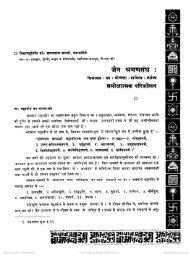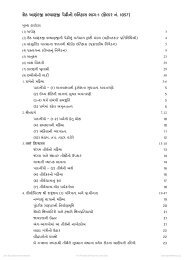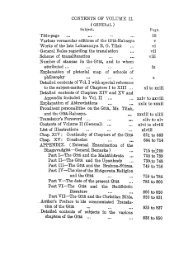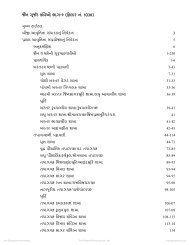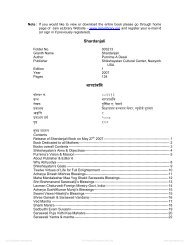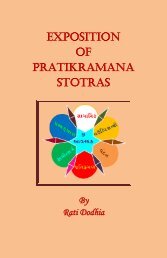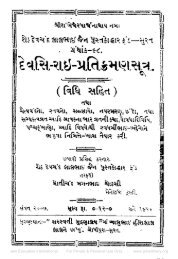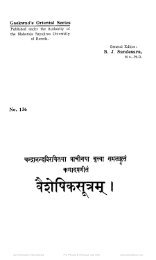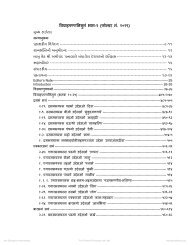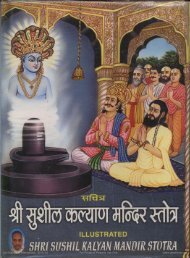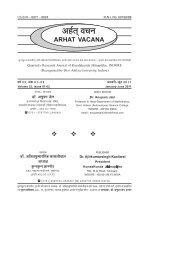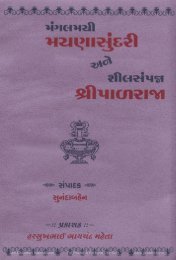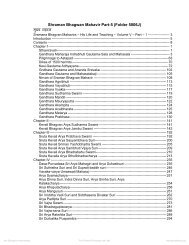Chapter - 08 Bon Po Religion - Jain Library
Chapter - 08 Bon Po Religion - Jain Library
Chapter - 08 Bon Po Religion - Jain Library
Create successful ePaper yourself
Turn your PDF publications into a flip-book with our unique Google optimized e-Paper software.
Shri Ashtapad Maha Tirth - II<br />
35<br />
<strong>Bon</strong> and <strong>Jain</strong> <strong>Religion</strong> – A comparative study<br />
Prashant Dave<br />
Introduction to <strong>Bon</strong><br />
Tibet, especially Kailash Mansarovar region is the land of snowy mountains. It inspires human<br />
consciousness to imbibe and breathe in the infinity. Its grandeur and grace invites us for inner<br />
patience. It is a place where inner mystery is being unveiled, in its purest form. It is a place<br />
where inner peace and tranquility are being ensured.<br />
No words, or mind can capture, thoughts are frozen, and I tilted on the tip of the pen cannot<br />
cling to the world, when personal prefix and suffix are invalidated, only the plane of peace and<br />
tranquility expands. We enter into a land of silence and delight. When we are disillusioned<br />
about the roaring voice of the world we can shrug off the pride, arrogance and vanity of<br />
human beings. We say goodbye to the world and enter into the abode of one’s own being.<br />
It is a land of peace, tranquility and nobility. This is a land of inner contentment a meeting<br />
point of <strong>Bon</strong> and <strong>Jain</strong>ism. This is the land of Mount Kailash, the land of Ashtapad. It is the<br />
most outstanding object on the surface of our own planet. It is a pure land, a land of reverence<br />
and revelation. It is a land of obeisance. It is a gifted land. The gift of the land is transparent<br />
delight, depth and silence. This is a land of grandeur and divinity. This is the abode of life. It<br />
is a meeting point of inner and outer harmony. It is an ideal of all religions and particularly<br />
for <strong>Bon</strong> and <strong>Jain</strong>ism. This is the shrine of the highest level of consciousness, the consciousness<br />
of Arhats and Siddhas.<br />
‘<strong>Bon</strong>’ was a way of life in ancient Tibet before the induction of Buddhism there. There is<br />
openness in ‘<strong>Bon</strong>’. Its passage begins from within, from inside to outside. It emerges not<br />
from the nature but it sprouts from the self. This is an essential characteristic of ‘Indo-Tibetan’<br />
religion and culture. <strong>Religion</strong> starts from self–search. World is an expansion of one’s own<br />
consciousness. Myths and Legends are the natural expression of religion.<br />
Incapability to sustain one’s life molded the ethical life of the people of Tibet to be more<br />
receptive, sympathetic, equitarian, enduring and simple. Agriculture and cattle breeding were<br />
the sole occupation of the people of Tibet. They borrowed the agricultural skill and this can<br />
be a clear indication of their connection to Rushabhdev.<br />
One important thing is that the region of Mount Tise and Lake Pham, which is the land of<br />
Rushabhdev and Ashtapad, is a part of ‘Shang Shung’ culture which is related to the ‘Pre Buddhist<br />
<strong>Bon</strong> <strong>Religion</strong>’.<br />
Ref. Vol. XVI Ch. 124 H Pg. 7334-7339<br />
<strong>Bon</strong> and <strong>Jain</strong> <strong>Religion</strong> - A comparative study<br />
412



